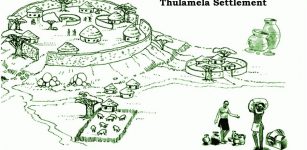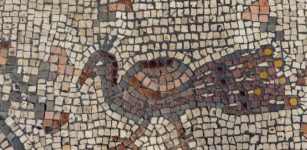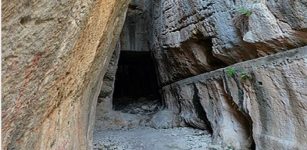Circular Stepped Pyramids Of Guachimontones And Teuchitlan Tradition – A Lost Ancient World In Mexico
A. Sutherland - AncientPages.com - A remarkable, ancient archaeological site Guachimontones (‘Los Guachimontones’) is located just outside the modest little town of Teuchitlán, Jalisco, 43 kilometers (26 miles) west of Guadalajara, Mexico.
At first, very little was known about who had built this remarkable place with rounded pyramids, several conical mounds or pyramids, terraced patios surrounded by circular ball games, an amphitheater, some terraces, buildings, and sophisticated ancient shaft tombs. Dating to the first centuries A.D., these tombs had small burial chambers at the bottom of vertical cuts up to 60 feet deep.
 Los Guachimontones. The dominant features at los Guachimontones are circular stepped pyramids in the middle of circular building complexes. The 60-foot (18 m) tall pyramid at Circle 2 has 13 high steps leading to an upper level, which was then topped with another 4 high steps. One of the most impressive archeological sites in all of western Mexico.
Los Guachimontones. The dominant features at los Guachimontones are circular stepped pyramids in the middle of circular building complexes. The 60-foot (18 m) tall pyramid at Circle 2 has 13 high steps leading to an upper level, which was then topped with another 4 high steps. One of the most impressive archeological sites in all of western Mexico.
The site was discovered by the late U.S. archaeologist Phil Weigand in 1970 and today, it is among the most visited archaeological sites in the country.
Weigand spent 29 years documenting a complex, highly organized society that had begun in western Mexico about 1000 BC and had reached its peak in 200 AD.
Guachimontones, home to approximately 40,000 people, was built by a unique culture, known as Teuchitlán Tradition, one of the pre-Hispanic cultures that flourished in western Mexico.
 Image credit: Esteban Tucci - CC BY-SA 3.0
Image credit: Esteban Tucci - CC BY-SA 3.0
Inhabitants of the city created small agricultural islands irrigated by an ingenious system of floodgates, dams, and canals and they traded in salt from the flats of the Sayula Basin of central Jalisco.
The city’s geographical location was certainly of great importance for the Teuchitlán tradition because these people lived right next to the third largest obsidian deposits in the world.
In fact, they controlled more than 1,000 obsidian mines, from which some 14,000 tons of the precious volcanic glass were extracted. Skilled craftsmen in Teuchitlán's workshops shaped the obsidian into swords, spearheads, mirrors of extraordinary quality, and unique, ultra-thin earrings.
The city’s geographical location was certainly of great importance for the Teuchitlán tradition because these people lived right next to the third largest obsidian deposits in the world.
However, the dominant features at los Guachimontones are circular stepped pyramids in the middle of circular building complexes.
According to Weigand, these structures, set in concentric layers of stone and turf, are not only unique in Mesoamerica but also not found anywhere else in the world.
Their cover is huge, with at least three such pyramids, and stone platforms for temples around them.
These so-called Circles of Guachimontones predate the Incas and Aztecs and lack any Olmec influence.
 Artist recreation of Los Guachimontones. From Beekman and Pickering (2016). Image credit: Herb Roe - CC BY-SA 4.0
Artist recreation of Los Guachimontones. From Beekman and Pickering (2016). Image credit: Herb Roe - CC BY-SA 4.0
The structures are unique in that they are based on concentric circles, not any kind of pyramid.
The main structure was built on a hilltop and used as a ceremonial site to worship the deity Ehecatl-Quetzalcoatl, a feathered serpent worshiped as the god of wind in many pre-Hispanic civilizations across Mexico.
Credit: Public Domain
It has 52 steps, corresponding to the number of weeks in a year and the number of years in the cycle of many Mesoamerican calendars, including the infamous Mayan calendar.
The site is also home to several rectangular platforms and two ball courts, commonly known in many Mesoamerican cultures, with competitors typically using their hips to somehow control the ball and move it from one end of the court to the other, and in some cases pass it through a ring.
Written by – A. Sutherland AncientPages.com Staff Writer
Copyright © AncientPages.com All rights reserved. This material may not be published, broadcast, rewritten or redistributed in whole or part without the express written permission of AncientPages.com
Expand for referencesMore From Ancient Pages
-
 Abundantia: Roman Goddess Who Was Shaking Her Gifts From Cornucopia – ‘Horn Of Plenty’
Featured Stories | Nov 4, 2019
Abundantia: Roman Goddess Who Was Shaking Her Gifts From Cornucopia – ‘Horn Of Plenty’
Featured Stories | Nov 4, 2019 -
 Exceptional Precision And Technical Mastery Of Iberian Archery From 7,000 Years Ago
Archaeology | Dec 27, 2024
Exceptional Precision And Technical Mastery Of Iberian Archery From 7,000 Years Ago
Archaeology | Dec 27, 2024 -
 Mysterious 210,000-Year-Old Apidima Skull Could Re-Write Human History
Archaeology | Jul 11, 2019
Mysterious 210,000-Year-Old Apidima Skull Could Re-Write Human History
Archaeology | Jul 11, 2019 -
 10 Great Ancient Mysteries Of North America
Featured Stories | Sep 30, 2015
10 Great Ancient Mysteries Of North America
Featured Stories | Sep 30, 2015 -
 Mysterious Ancient Village In A Prehistoric Anomalous Zone – Dangerous Underground Secret – Part 2
Ancient Mysteries | Jul 28, 2020
Mysterious Ancient Village In A Prehistoric Anomalous Zone – Dangerous Underground Secret – Part 2
Ancient Mysteries | Jul 28, 2020 -
 Mysterious Ancient Circular Structure Discovered In Turkey – Has Zippalanda, The Lost City Of The Hittites Been Found?
Archaeology | Dec 27, 2022
Mysterious Ancient Circular Structure Discovered In Turkey – Has Zippalanda, The Lost City Of The Hittites Been Found?
Archaeology | Dec 27, 2022 -
 Enigmatic Ancient Kingdom Of Thulamela Created By Mysterious Shona People
Civilizations | Dec 28, 2016
Enigmatic Ancient Kingdom Of Thulamela Created By Mysterious Shona People
Civilizations | Dec 28, 2016 -
 Intact 1,800-Year-Old Roman Sarcophagus With Unexpected Treasures Found In France
Archaeology | Sep 26, 2023
Intact 1,800-Year-Old Roman Sarcophagus With Unexpected Treasures Found In France
Archaeology | Sep 26, 2023 -
 On This Day In History: Joan Of Arc Was Captured By The Burgundians – On May 23, 1430
News | May 23, 2016
On This Day In History: Joan Of Arc Was Captured By The Burgundians – On May 23, 1430
News | May 23, 2016 -
 Qilin – One Of Four Noble Animals In Chinese Myths And Legends
Chinese Mythology | Jan 26, 2021
Qilin – One Of Four Noble Animals In Chinese Myths And Legends
Chinese Mythology | Jan 26, 2021 -
 Undersea Scans Reveal Astonishing Ancient Submerged World Of The Adriatic Sea
Archaeology | May 11, 2024
Undersea Scans Reveal Astonishing Ancient Submerged World Of The Adriatic Sea
Archaeology | May 11, 2024 -
 Biblical Mosaic Depicting Miracles Of Jesus Discovered At The ‘Burnt Church’ In Hippos
Archaeology | Sep 24, 2019
Biblical Mosaic Depicting Miracles Of Jesus Discovered At The ‘Burnt Church’ In Hippos
Archaeology | Sep 24, 2019 -
 Thousands Of Sacred ‘Images’ With Unknown Signs Hidden In A Monastery Could Be World’s Oldest Alphabet
Ancient Mysteries | Jun 9, 2021
Thousands Of Sacred ‘Images’ With Unknown Signs Hidden In A Monastery Could Be World’s Oldest Alphabet
Ancient Mysteries | Jun 9, 2021 -
 A Scientific Surprise: Bering Land Bridge Formed Late During Last Ice Age
Archaeology | Dec 27, 2022
A Scientific Surprise: Bering Land Bridge Formed Late During Last Ice Age
Archaeology | Dec 27, 2022 -
 Spectacular Vespasianus Titus Tunnel – An Ancient Roman Engineering Marvel
Ancient Technology | Aug 30, 2018
Spectacular Vespasianus Titus Tunnel – An Ancient Roman Engineering Marvel
Ancient Technology | Aug 30, 2018 -
 Bacho Kiro Cave: Genomes Of The Earliest Europeans – Sequenced
Archaeology | Apr 8, 2021
Bacho Kiro Cave: Genomes Of The Earliest Europeans – Sequenced
Archaeology | Apr 8, 2021 -
 Rare Ancient Clothes And Shoes Found Under The Ice At The Lost Lendbreen Mountain Pass
Featured Stories | Feb 9, 2023
Rare Ancient Clothes And Shoes Found Under The Ice At The Lost Lendbreen Mountain Pass
Featured Stories | Feb 9, 2023 -
 Tiresias – Unusual Prophet Who Turned Into A Woman For Seven Years
Featured Stories | May 16, 2020
Tiresias – Unusual Prophet Who Turned Into A Woman For Seven Years
Featured Stories | May 16, 2020 -
 Hamingja – Norse Guardian Spirit Bringing Good Luck From Generation To Generation
Myths & Legends | May 20, 2024
Hamingja – Norse Guardian Spirit Bringing Good Luck From Generation To Generation
Myths & Legends | May 20, 2024 -
 Never-Before-Seen Amazon Rock Art Reveal People Lived With Giant Ice Age Animals
Archaeology | Dec 5, 2020
Never-Before-Seen Amazon Rock Art Reveal People Lived With Giant Ice Age Animals
Archaeology | Dec 5, 2020


